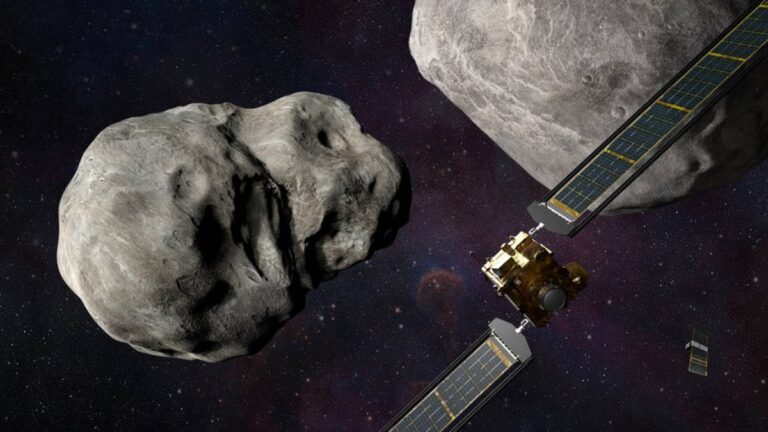About 5 1/2 years from now, astronomers predict, an asteroid roughly as large because the Empire State Constructing is tall will streak via area inside 20,000 miles (32,200 km) of Earth, the closest any ideally celestial physique of that dimension could have come to our planet in trendy historical past.
When that occurs, a spacecraft launched by NASA in 2016 is predicted to have the ability to present an in depth examination of this uncommon shut encounter.
The mission, led by College of Arizona scientists, is predicted to offer insights into planetary formation and data that may inform efforts to construct a protection system towards doable doomsday asteroid collisions with Earth.
On the time of its discovery in 2004, the asteroid Apophis, named after a demon serpent that embodies evil and chaos in historical Egyptian mythology, appeared to pose a critical risk to Earth, with scientists predicting a possible collision in 2029. Refined observations have since reigned supreme. out of any threat of impression for not less than one other century.
Nonetheless, its subsequent method in 2029 will deliver the asteroid inside a cosmic cat’s whiskers of Earth — lower than a tenth of the moon’s distance from us and effectively throughout the orbits of some geosynchronous Earth satellites.
The spacecraft now headed for a rendezvous with Apophis is OSIRIS-REx, which made headlines by choosing up a soil pattern from one other asteroid three years in the past and sending it again to Earth in a capsule that made a parachute touchdown in Utah in September.
The second act of the spacecraft
As an alternative of retiring the spacecraft, NASA renamed it OSIRIS-APEX — quick for APophis EXplorer — and fired its thrusters to set it on target for the subsequent goal.
The Apophis expedition was described in a mission abstract printed within the Planetary Science Journal.
Apophis, elongated and considerably peanut-shaped, is a rocky asteroid regarded as composed primarily of silicate supplies together with iron and nickel. With a diameter of about 1,110 ft (340 meters), it ought to go inside about 19,800 miles (31,860 km) of Earth’s floor on April 13, 2029, and grow to be seen to the bare eye for a couple of hours, stated Michael Nolan, deputy superintendent. to the mission on the College of Arizona.
“It will not be this wonderful present,” Nolan stated, however it’s going to seem as some extent of mirrored daylight within the evening sky over Africa and Europe.
A big asteroid passing this near Earth is estimated to happen about as soon as each 7,500 years. Apophis’ flyby is the primary such encounter predicted upfront.
The tidal pull of Earth’s gravity is prone to trigger measurable perturbations to the asteroid’s floor and movement, altering its orbital path and rotational spin. Tidal forces can set off landslides on Apophis, dislodging rocks and mud particles to create a comet-like tail.
The spacecraft is about to watch asteroid Earth flyby because it approaches and ultimately catches up with Apophis. These pictures and knowledge can be mixed with ground-based telescope measurements to detect and quantify how Apophis modified because it handed Earth.
OSIRIS-APEX is deliberate to stay close to Apophis for 18 months – orbiting, maneuvering round it and even hovering simply above its floor, utilizing rocket thrusters to kick up free materials and reveal what lies beneath.
Planetary Science and Protection
Like different asteroids, Apophis is a relic from the early photo voltaic system. Its mineralogy and chemistry are largely unchanged for greater than 4.5 billion years, offering clues to the origin and evolution of rocky planets like Earth.
An in depth research of Apophis may present planetary protection specialists with worthwhile details about the construction and different properties of asteroids. The extra scientists know concerning the composition, density, and orbital conduct of such celestial “rubble poles,” the better the probabilities of devising efficient asteroid-deflection methods to mitigate impression threats.
NASA intentionally crashed a spacecraft right into a small asteroid final yr in a planetary protection check that pushed the rocky object off its regular path, marking the primary time humanity altered the pure movement of a celestial physique.
Apophis is considerably bigger than the asteroid, however small in comparison with the one which hit Earth 66 million years in the past and worn out the dinosaurs.
Whereas not giant sufficient to pose an existential risk to life on Earth, an Apophis-sized asteroid hitting the planet at hypersonic velocity may nonetheless destroy a significant metropolis or area, Nolan stated, with ocean impacts triggering tsunamis.
“It would not be globally catastrophic within the sense of mass extinctions,” however an impression “would undoubtedly fall beneath the class of unhealthy,” Nolan stated.
“This factor is available in at many miles a second if it hits. And at that velocity, it does not actually matter if it is fabricated from gravel or ice or rock or no matter. It is only a huge, heavy factor, that strikes quick.” Nolan added.
© Thomson Reuters 2023

